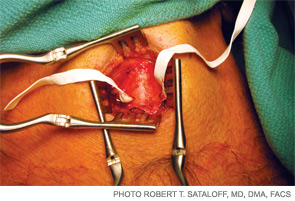Once health problems are discovered and addressed, patients begin vocal therapy, which involves aerobic exercise to increase lung capacity and voice training to strengthen the vocal folds.
Explore This Issue
April 2010As a person’s vocal folds age and the intrinsic laryngeal muscles atrophy, the folds may no longer close tightly, allowing air to escape and creating a breathy voice. The person develops presbyphonia, characterized by hoarseness, reduced loudness, increased breathiness, strain and tremor. Filler injections can temporarily add mass to the vocal folds, while autogenous adipose tissue injections can produce a permanent increase in density. If the vocal folds need more bulk, tiny shims made out of Gore-Tex or Silastic can be implanted.
“We make an incision in a skin crease over the lower part of the larynx and make a small hole in the laryngeal cartilage through which we place the shims,” Dr. Sataloff said. “This brings the vocal folds closer to the midline, so, instead of a gap, the patient has good, firm vocal fold contact, and hence a strong voice with low effort.”

Growing Popularity
While some laryngologists are uncomfortable with the idea of improving the voice strictly to enhance its sound, the voice lift as a cosmetic procedure seems to be gaining in popularity. In 2006, an episode of “Nip/Tuck,” a series on cable channel FX about cosmetic surgeons, featured Kathleen Turner as a phone-sex worker who wanted to make her voice, ravaged by years of scotch and cigarettes, sound younger. And various Web sites tout the voice lift as a way to sound as young as cosmetic surgery can make you look.
Dr. Sataloff points out that, whether we like it or not, the voice contributes significantly to the overall impression a person makes. “People have a natural tendency to infer that someone with an infirm, unsteady voice has an infirm, unsteady mind,” he said.
Voice problems can also degrade quality of life, according to recent research. “We looked at associations in the elderly population between hearing loss and voice problems,” said Seth Cohen, MD, MPH, an assistant professor of Otolaryngology-Head and Neck Surgery at Duke University Medical Center Department of Surgery and a laryngologist in the Duke Voice Care Center in Durham, N.C. “Our research doesn’t prove that hearing loss causes voice problems, but it shows that the odds of having voice problems are increased if you have hearing loss. Those with both hearing loss and voice problems had greater depression symptom scores than those who had neither.” (The Laryngoscope. 2009;119(9):1870-1873.)
As voice problems become more widespread with increased longevity, treatments are likely to become more effective, according to Dr. Johns. “If we could rejuvenate tissue through biomanipulation, we would have treatment options that could advance the possibilities for presbyphonia,” he said. “And these options may not be as far off as it seems. There are outstanding researchers looking for ways to deliver growth factors and stem cells to rejuvenate aging vocal fold tissue.”
Leave a Reply